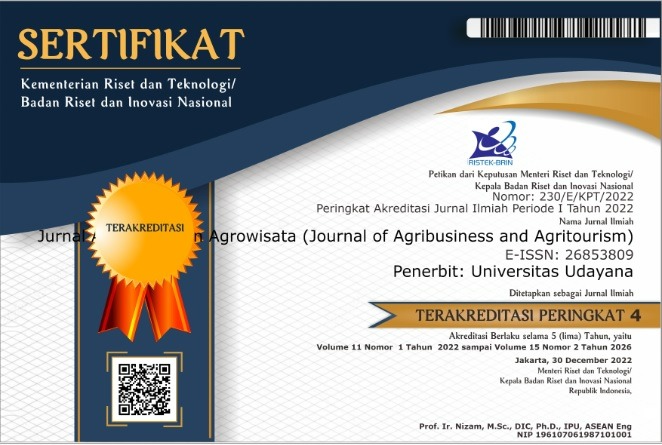Perbandingan Pendapatan Budidaya Udang Vaname dengan Sistem Tradisional dan Empang Plastik di Kabupaten Jembrana
Abstract
The Comparison of Vannamei Shrimp Farming Income with Traditional System and HDPE Lined Ponds in Jembrana Regency
Shrimp farming has become a priority in the development of aquaculture in Indonesia because that possesses a high economic value. Vannamei shrimp was recently introduced as a priority commodity in Indonesia. Busmetik is one of the intensive shrimp farming technology using high-density polyethylene (HDPE) plastics as inner lining ponds. However, intensive shrimp farming was only able to be practiced by large-scale farmers because it requires a greater amount of costs. This research aims to (1) identify the comparison of vannamei shrimp farming income with traditional system and plastic lined-ponds, and (2) to find out the obstacles faced by farmers in vannamei shrimp farming. This study was conducted in Jembrana regency. The site location was determined purposely because it is a center for vannamei shrimp production in Bali Province. The selection of respondents was done by using a proportional random sampling technique with 26 traditional shrimp farmers and 8 plastic lined-pond shrimp farmers. The method of analysis used in this study is comparative analysis of farm income, R/C Ratio, and descriptive analysis. Farming income is obtained in one season of production with an average of 75 days of cultivation. The results showed that the average income of traditional shrimp farmers was Rp. 17,969,856 per hectare per season, while the average income of lined ponds shrimp farmers at Rp. 135,623,051 per hectare per season. R/C ratio of traditional shrimp farmers is 1,22 whereas the lined-ponds shrimp farmers is 1,33 and statistic test result is significant. The obstacles of shrimp farming are pests and diseases, climate changes, and large capital issue.
Downloads
References
Erlangga, E. 2012. Budidaya Udang Vannamei. Tangerang: Pustaka Argo Mandiri.
Ghozali, I., and J. Castellan. 2007. Statistik Non Parametrik : Teori dan Aplikasi dengan Program SPSS. Semarang: Univesitas Diponegoro.
Haliman, R. W., dan D. Adijaya. 2007. Udang Vannamei. Jakarta: Penebar Swadaya.
Kementrian Kelautan dan Perikanan. 2018. Kelautan dan Perikanan dalam Angka Tahun 2018. Jakarta: Pusat Data, Statistik dan Informasi.
Kordi, K. M. G. H. 2007. Budidaya Udang Vanname. Surabaya: Indah.
Rahayu, H. 2013. Petunjuk Teknis Budidaya Udang Skala Mini Empang Plastik. Banten: STP Press.
Soekartawi. 2016. Analisis Usahatani . Jakarta: UI Press.
Sugiyono. 2017. Metode Penelitian Kuantitatif, Kualitatif, dan R&D. Bandung: Alfabeta.
Supono. 2017. Teknologi Produksi Udang. Yogyakarta: Plantaxia.







